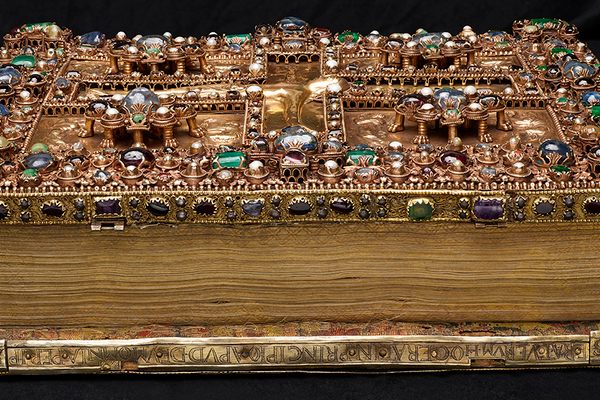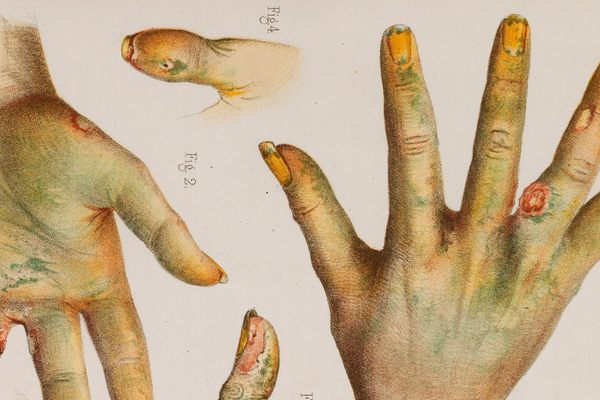Codex Gigas: Who Drew the Devil in This Massive Medieval Bible?
The Codex Gigas, also known as the Devil’s Bible, is the largest medieval manuscript still in existence—with an even bigger legend behind it.
Listen and subscribe on Apple Podcasts, Spotify, and all major podcast apps.
Amanda McGowan: Today I want to tell you a story about a book.
Dylan Thuras: Okay.
Amanda: It’s a very special book. It’s called the Codex Gigas, which is Latin for big book. But before I get into what it is and what’s in it, I want to tell you a little bit of a story about how it was made. A legend, if you will. A fantastical tale.
Dylan: Okay. This is a book with a backstory.
Amanda: So imagine for a minute that you are a monk in medieval times, the year is, you know, 1200 or something. We’re in the Middle Ages in Europe, specifically in Bohemia, which is now like where the Czech Republic is. But you are actually in deep trouble at work. So your monastery has very, very strict rules. And you broke the rules doing something.
Dylan: I’m probably a shabby monk. I feel like I’d be not a good monk. Okay, so this is a—
Amanda: Dylan the Shabby is your monk name.
Dylan: Dylan the Shabby. Correct. Exactly. So what have I done? I don’t know.
Amanda: So you’re in trouble. I don’t know what you’ve done. Maybe you like stole a donut or something from the cafeteria or you like farted at church or something. Like something bad—
Dylan: Sounds right.
Amanda: —happened. And well, you’re facing a very serious punishment, which is the other monks at the abbey are going to actually enclose you into a wall.
Dylan: That is bad. That’s pretty harsh. Okay.
Amanda: So that’s tough. But you do have a kind of sneaky way that you can get out of this, okay? So you say, please don’t enclose me into a wall, I will copy out the entire Bible by hand over the course of one evening.
Dylan: So the only way I get out of being buried inside of a wall is I have to copy the entire Bible in one night.
Amanda: Yeah, it seems reasonable and doable, right?
Dylan: Yeah. Okay. All right. So yeah, I’d go for it. I can do it.
Amanda: Go for it. I mean, you might as well try. So it’s a dark and stormy night. Cue the sound effects, right? And you are locked up in this room and you’re scribbling away, Old Testament, sentence one, going fast, right? But the night is slipping away. Your hand is cramping up. You’re so worried you’re never going to finish. So in a little bit of a moment of desperation or inspiration or whatever you want to call it, you cry out for help to whoever will come save you. And you know who shows up?
Dylan: Uh-oh. I think it’s bad.
Amanda: The devil.
Dylan: In my hour of weakness.
Amanda: The devil says, hey, Dylan the Shabby. What’s up? And he says, you know what? I will help you finish this book, but you have to do something for me.
Dylan: Uh-oh.
Amanda: You have to make a big, beautiful portrait of me in the middle of your Bible. How does that sound?
Dylan: Honestly, in this situation, it’s great. I’m about to be bricked into a wall. Yeah, I’m drawing you. I can draw a picture of Satan in one night. You do the rest, homie. Take the wheel. I got it.
Amanda: Yeah. Yeah, kind of like an okay trade, right?
Dylan: Not bad.
Amanda: But anyway. So yeah, that’s exactly what you do. You copy out this Bible and you put a big, scary, ooh, scary picture of Satan right in the middle.
Dylan: I like this story. Is this a real book then? Is there like this Bible with this Satan image inside of it?
Amanda: So as you may have guessed, the story might be slightly exaggerated a little. However, the reason that maybe this fantastic legend popped up around this particular book is that this book in question is very strange. So this is a book called the Codex Gigas. It’s the largest medieval manuscript that still exists today. Probably the largest one ever made, if we had to guess. And it very inexplicably has a big portrait of Satan in the middle of it.
Dylan: The Codex Gigas.
Amanda: Cue the Gregorian chant.
I’m Dylan Thuras.
And I’m Amanda McGowan.
Dylan: And this is Atlas Obscura, a celebration of the world’s strange, incredible, and wondrous places. And today we are going to explore this story, explore whether a monk in the Middle Ages decided to put a giant mega Satan in his copy of the Bible, and why. Yeah.
Amanda: And why. And honestly, the story gets even weirder from there after he makes it. It goes on this whole other fantastic journey. So, this is the story of the Codex Gigas, also known as the Devil’s Bible.
Dylan: Come with us. You’ll never be the same.
This is an edited transcript of the Atlas Obscura Podcast: a celebration of the world’s strange, incredible, and wondrous places. Find the show on Apple Podcasts, Spotify, and all major podcast apps.

Dylan: All right. So show me a picture of this. I would like to see what I’m actually imagining.
Amanda: Yes. So I did promise a big, scary picture of the devil. And I have a picture of those pages. So I’m showing them to you now. What are you making of this image?
Dylan: I am seeing a—honestly, it’s like a pretty fun drawing. It’s a little, dare I say, silly.
Amanda: It’s a little silly.
Dylan: There’s this kind of crouching creature. It’s got weird taloned sort of, you know, chicken legs. A small loincloth. So I appreciate the modesty here. A loincloth. And then like, you know, little flaming taloned hands and a big green face with big round eyes and horns and tusks maybe coming out of the mouth. Tusks, or snakes, or flames, or something.
Amanda: Yeah. Tusks or like—or a tongue or two tongues. Unclear.
Dylan: Hard to say. It doesn’t look like the devil I expect.
Amanda: Yeah. And I also want to give you a sense of how large this is. So that’s another thing that makes it kind of surprising. So if you go to the next image, you can see there’s a guy kind of turning the pages of the book. And this is the page with the devil facing.
Dylan: Oh, wow. This is like half a human bigger than that. It’s like the size of my 10-year-old.
Amanda: Yeah. I think it’s around three feet tall. And if it’s fully open, somewhat like four feet wide. It also is very heavy. It weighs about 165 pounds.
Dylan: What else is in this book? Is the rest of it like normal Bible stuff?
Amanda: Yes and no. So there is a normal Bible in it. There’s the Old and New Testament. But it also includes a lot of other stuff too. So there’s some history material. There’s a copy of the work of Josephus, the famous Jewish Roman historian. There’s some Bohemian history. There’s a calendar. There’s some medical texts, kind of normal stuff. But then it takes a bit of a turn to things you might not expect. So there’s a section for spells.
Dylan: Like magical spells?
Amanda: Yeah, like conjuration. So if you imagine an exorcism, these would be Latin phrases that a priest would use to draw an evil spirit out of a body. My favorite part of the book is the confessional section of the book where the person writing it talks about all of the many temptations that face a man of the cloth. So he mentions pride, and envy, and gluttony, and lust, and bestiality.
Dylan: Wow. This is a thorough list. This monk is like, listen, it gets rough out here. All right. So let’s just, you know—ignoring sort of the this was made by the devil piece of it—what do we actually know about this book? Do we know anything historically about who made it or why they made it?
Amanda: That’s a great question. And it’s maybe the question about the Codex Gigas. So we actually are not sure exactly who made it or even when or where. We can guess that it was created in the early 13th century somewhere at an abbey in Bohemia. And the big question is going back to the legend, you know, was this made by one single guy or was it produced kind of more similar to other medieval manuscripts at the time, which would have been by a group of monks working in a team like at a scriptorium?
Dylan: I like the idea that it was made by a team, but then like one of the team members, like, you know, Paul, they’re like, okay, it’s your turn, Paul. Just do the section we told you. There’s just a normal section where you do some herbarium. And he’s like, oh, yeah, no, I got it.
Amanda: I got it. I got it. I got it.
Dylan: And then you bring back the thing, and they’re like, god!
Amanda: Paul!
Dylan: What are all these spells in here? Paul, why’d you draw a giant devil? We can’t—it’s in the book now. We can’t take it apart. Well, I guess this is just going in the book. Is there any way to know, like, based on analysis, handwriting analysis, whether this was one person or multiple people?
Amanda: Yes. Well, yes, asterisk. So there have been many investigations, analyses of this text over the 800 years since it was made. And National Geographic actually around 15 years ago did a big investigation with exactly, as you said, handwriting experts, manuscript experts, people like that. They found that the calligraphy was very, very consistent throughout the book. It didn’t seem like multiple people’s handwriting. It seemed like one person. The ink was very consistent. And they also, to go back to how we were describing the devil picture, they determined that the artwork looked a little off. Like it was maybe not produced by someone who was a trained artist, like a very talented but untrained amateur, perhaps.
Dylan: Self-taught artist.
Amanda: Yes.
Dylan: It’s got the peculiarities of somebody who’s just like, when I draw devils, this is what they look like.
Amanda: That’s what it looks like.
Dylan: They’re just like fun little guys.
Amanda: Yeah.
Dylan: Okay. I would assume this took, actually, a very long time for one person to make.
Amanda: Yeah. I think that’s a very fair assumption to make. So in that same National Geographic analysis, they estimate that it would have taken probably 25 to 30 years.
Dylan: Yeah.
Amanda: So this is one person’s life’s work, essentially.
Dylan: Yes.
Amanda: And we maybe even know who it is. The National Geographic investigation found some kind of, I wouldn’t say it’s a signature, but they did find a mention of a specific person named Herman Inclusus.
Dylan: Okay.
Amanda: Or Herman the Recluse in Latin. So this might be Herman’s reclusive 30-year project.
Dylan: I could see what he’s doing in those reclusive periods. Okay. So we’ve got this book, maybe made by the devil, maybe made by a monk named Herman the Recluse. What happens to this book when it’s done?
Amanda: The book was sort of passed from monastery to monastery for a couple hundred years. And it acquired this reputation of being like an eighth wonder of the world. And if you look in the book, there’s actually, you know, kind of like your eighth grade math textbook, like the monasteries would write in like who had it, you know, at what time.
Dylan: Yeah, like Jeff was here, you know, like, have a great summer.
Amanda: Exactly. Drawing that little S thing that everyone always draws. But the story, in my opinion, gets perhaps even more interesting when we get into the late 1500s. And this is a time when this part of the world is now the Holy Roman Empire, and the emperor, Rudolph II, becomes obsessed with the Codex Gigas, and he decided that he needed to have it.
Dylan: Why did Rudolph want this book so bad? What was his obsession with it about?
Amanda: Yes. So Rudolph was very interested in the occult, the esoteric. His origin story was when he was still a prince before he became the emperor, he had a horoscope prepared for him by Nostradamus, the famous, you know, magician, astrologer. And Nostradamus predicted that he would become the emperor, and then he did. So he was like, oh my God, this stuff really works! So he started collecting all of these sort of, you know, alchemical textbooks and magical devices and wild animals. He had a lion that would wander around the palace that was just like his pal, his friend. And he put a lot of this crazy cool stuff in a cabinet of curiosities at his palace in Prague, the Kunstkammer. And he decided that he really needed the Codex Gigas for his collection. But I don’t know if it was the Bible or just whatever else was going on in his life, but he became super reclusive. He kind of withdrew into his own inner world. And eventually his advisors or his family or something like wrenched the throne away from him, and it threw the entire Holy Roman Empire into complete chaos.
Dylan: Dude, don’t take the giant cursed Satan book by the recluse. This is like obviously, you know. Okay, so what, so Rudolph gets the book, kind of loses it, goes into the deep end, drawn into the occult. What happens to the book after that?
Amanda: The Holy Roman Empire is thrown into disarray. It turns into the Thirty Years’ War, and all of these other European countries get involved.
Dylan: Such a long war.
Amanda: And from the other side of Europe, the country of Sweden is peering over and seeing this and thinking, hey, there’s an opportunity here. So Sweden invades, they take over Prague, they take over the castle. So they lug this, again, 200-pound book off to Sweden, 900 miles across Europe. And the Codex Gigas and all of the kind of objects in the Kunstkammer were housed in the Royal Palace in Sweden for many, many years, until in 1697, there was this giant fire that broke out in the Royal Palace, and some heroic person decided to save the Codex Gigas. They ran into the library. They chucked it out the window to save it from the fire, and it supposedly hit a guy on the way down. But the book survived.
Dylan: Of course. Yes, the devil is doing their work through this book, just crushing some unsuspecting person who’s like, hey, what’s happening? Oh no!
Amanda: There’s a guy watching the fire. Very Monty Python-esque, yeah.
Dylan: All right. Now I’m in the Rudolf camp. I’m like, what is it going to take to get me this book?
Amanda: I got to get it.
Dylan: This person-crushing, giant devil book.
Amanda: Well, I could tell you, probably. I mean, so the book today is on display. It’s now in the Swedish National Library in Stockholm, and you can go check it out. There’s also a bunch of scans of it online. The Library of Congress has full color images of it. But just be careful if you’re at home. Maybe don’t read any of those Latin phrases out loud.
Dylan: You don’t know what’s in this book.
Amanda: You just never know what you’re going to get.
Dylan: You do not know what’s going on with this book.
Amanda: Yeah.
Dylan: This book is awesome. I love that somebody’s weirdo, recluse, outsider art monk project has made it all these years. On Etsy, if you have $515, you can get yourself a reproduction copy large-scale book of the Codex Gigas.
Amanda: It’s a coffee table book where the book is also the size of a table.
Dylan: Yes, yes, yes.
Listen and subscribe on Apple Podcasts, Spotify, and all major podcast apps.
Our podcast is a co-production of Atlas Obscura and Stitcher Studios. The people who make our show include Doug Baldinger, Chris Naka, Kameel Stanley, Johanna Mayer, Manolo Morales, Amanda McGowan, Alexa Lim, Casey Holford, and Luz Fleming. Our theme music is by Sam Tindall.























Follow us on Twitter to get the latest on the world's hidden wonders.
Like us on Facebook to get the latest on the world's hidden wonders.
Follow us on Twitter Like us on Facebook